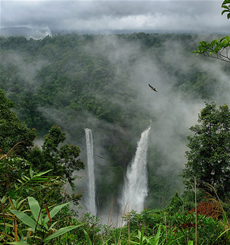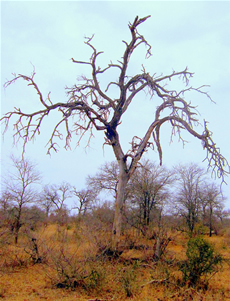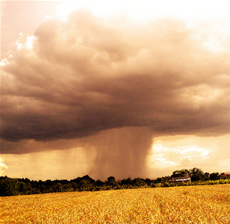Agriculture
Climate is described by the average of weather conditions at a place or in a region, usually recorded as both the mean and the extremes of temperature, precipitation, and other conditions.
Resources are the factors and characteristics of the natural environment that people find useful, including climate, land, soil, water, minerals, and wild vegetation. Thus, climate itself is a resource, affecting the character of the plant life and other resources it supports.
The nature and distribution of wild vegetation are to a large degree the products of climate: the temperature, moisture, solar radiation, and other environmental conditions that characterize a region. The major global vegetation types that accompany forest, shrub, grassland, desert, rain forest, tundra, and other biomes reflect climatic controls.
Solar radiation is the basic determinant of climate. The sun?s rays are vertical at some time of the year only in the tropics, between the Tropic of Cancer (23.5 degrees north latitude) and the Tropic of Capricorn (23.5 degrees south latitude).
These lines determine where the greatest heat supply is found; regions poleward of about 40 degrees north and south latitudes actually have a net loss of reradiation to outer space and depend upon a heat supply from the tropics, which is carried poleward by the general circulation of the atmosphere. The general circulation is the average of wind flow at the surface of the earth and is driven by the surplus of solar radiation in the tropics.
Equatorial Climates
By definition, tropical climates do not experience freezing temperatures, have the least variation in length of day, and consequently experience the least ?seasonality? of any latitudes.
Seasons in the tropics are characterized more by precipitation contrasts??dry? and ?wet??than by summer and winter temperatures. The greatest combination of heat and moisture resources on the earth?s surface, especially important in creating the conditions under which tropical rain forests flourish, is near the equator.
The depth to which rock and soils are weathered and leached (mineral plant foods dissolved and removed by groundwater flow) is greater near the equator than elsewhere on the earth?s surface. Continuous high temperatures work against carbon storage in the soils.
Under wild vegetation conditions, where the rain forest canopy protects soils from rain drop impact, erosion rates are not as high as one would expect from the intense rain showers. On sloping land, however, the soils become saturated and flow down slope, often catastrophically in landslides.
Where wild vegetation has been removed by human activity, such as farming or development of urban centers, erosion and mass wasting (landslides) are exacerbated during rainy seasons and cause considerable loss of life and property damage.
With increasing distance from the equator, the tropics experience more pronounced seasons, particularly in moisture resources. Precipitation totals decline, and drought risk increases.
Dry seasons are expected annually because of the shifting of the general circulation of the atmosphere. The timing and extent of this shift determine whether a region experiences drought.
East and South Asia are most affected by shifting atmospheric circulation and the resulting wet and dry seasons. Africa also has pronounced wet and dry seasons.
Droughts in this part of the world result in famine: An estimated one million people died in the Sahelian droughts of the late 1960?s and 1970?s. Thus climate must be defined both in terms of averages and of extremes. Extremes result in hazards that have dire consequences for the inhabitants of the affected region.
The probability of drought increases as precipitation averages decrease. Additionally, most tropical rainfall takes the form of intense thunder showers, which are spatially highly variable.
One farm may be drenched by rain while its neighbors continue to be tormented by drought. In addition to drought risk on the margins of the tropics, a major climatic hazard is the tropical cyclone, also called a hurricane or typhoon.
Cyclones rarely affect the equatorial zone but frequent the tropical transition to the subtropics and midlatitudes. Movement of tropical cyclones is easterly in their early and middle stages, following the general circulation known as the trade winds.
The Subtropics
The climates that exist in the subtropics, poleward of the tropics, depend on the side of the continent: West sides are deserts or subtropical drylands; east sides are the humid subtropics, a transition zone with cooler temperatures and more risk of frost with greater distance from the equator. The humid subtropics are subject to occasional easterly flow weather systems, including tropical cyclones.
While cyclones represent a serious hazard, claiming both lives and property, these easterly systems also deliver moisture and thus reduce the possibility of drought. The generally warm temperatures and moist conditions make these climates some of the most productive for crop growth, exceeding the potential of the tropics.
In the subtropics, leaching of soils and high erosion rates on cleared fields are nearly as great a problem as in the tropics.
The west coast drylands, which include all the world?s major deserts-Sahara, Atacoma, Kalahari, Australian, and North American?are a consequence of the general circulation of the atmosphere, which in these locations makes the swing from the prevailing westerlies of the middle latitudes to the easterly trade winds.
In the process, high atmospheric pressures prevail, and winds are descending or subsiding, and therefore warming?just the opposite of the conditions required for rainfall.
Drylands may extend deep into the continents, as in North America and especially in Africa and Asia. The dryness of the Sahara blankets the Middle East and extends northward into Central Asia.
Temperatures along the equator ward flank of these five major dryland zones are tropical, and where irrigation water is available, tropical plants may be grown. Most of the drylands are subtropical or midlatitude, and thus they experience frost as well as drought hazard.
Weathering and erosion are appreciably less in the drylands, owing to the absence of moisture. Leaching of the soils is virtually absent. Instead, salts in the soils can build up (salinization) to levels that are toxic to most plants?another climate-related hazard.
The Midlatitudes
The midlatitudes extend from the subtropics to the polar climates of the Arctic and Antarctic. Temperatures follow a transition from warm on the equator ward flank to too cold for agriculture nearer the poles. This is the realm of the westerlies, with extratropical cyclones delivering most of the weather.
It is a zone of contrasting conditions, year by year and day by day, ranging from warmer than average to colder than average, from too humid to too dry on the inland dryland border. The hazards of extreme temperature and precipitation often dominate life, as tropical and polar air masses converge to create the cyclones that march from west to east.
Drought risk is most important on the dryland border and results in the world?s great grasslands. Summer heat may be a hazard on occasion. Nearly every winter brings storms with freezing rain, high winds, and heavy snowfalls, particularly on the eastern sides of the continents.
The eastern sides are also afflicted with intense summer storms, such as the tornadoes of North America (a winter phenomenon in the adjoining humid subtropics) and the tail ends of hurricanes and typhoons, as these storms become caught up in westerly circulation and curve poleward again.
The Arctic fringe of the mid latitudes is too cool for significant agriculture but yields the great subarctic forests of Canada, Scandinavia, and Russia.
- Biosphere Concept
Biosphere Concept The term "biosphere" was coined in the nineteenth century by Austrian geologist Eduard Suess in reference to the 20-kilometer-thick zone extending from the floor of the oceans to the top of mountains, within which all life on earth exists....
- Deserts
DesertRegions characterized by 10 inches or less of precipitation per year as considered deserts. Plants in desert biomes are typically specialized to endure the harsh conditions found there. Deserts are regions, or biomes, too dry to support grasslands...
- Drought
DroughtDrought is a shortage of precipitation that results in a water deficit for some activity. Droughts occur in both arid and humid regions. One problem in analyzing and assessing the impacts of drought, as well as in delimiting drought areas, is simply...
- Rain Forest Biomes
Rain Forest BiomesTropical forests exist in frost-free areas between the Tropic of Cancer and the Tropic of Capricorn. Temperatures range from warm to hot year-round. These forests are found in northern Australia, the East Indies, Southeast Asia, equatorial...
- Savannas And Deciduous Tropical Forests
Savannas are areas of continuous grass or sedge cover beneath trees that range from scattered, twisted, and gnarled individuals to open wood lands. Deciduous tropical forests have continuous to open forest cover and undergo a leafless period during a...
Agriculture
Climate and Resources
 |
| Climate and Resources |
Resources are the factors and characteristics of the natural environment that people find useful, including climate, land, soil, water, minerals, and wild vegetation. Thus, climate itself is a resource, affecting the character of the plant life and other resources it supports.
The nature and distribution of wild vegetation are to a large degree the products of climate: the temperature, moisture, solar radiation, and other environmental conditions that characterize a region. The major global vegetation types that accompany forest, shrub, grassland, desert, rain forest, tundra, and other biomes reflect climatic controls.
Solar radiation is the basic determinant of climate. The sun?s rays are vertical at some time of the year only in the tropics, between the Tropic of Cancer (23.5 degrees north latitude) and the Tropic of Capricorn (23.5 degrees south latitude).
These lines determine where the greatest heat supply is found; regions poleward of about 40 degrees north and south latitudes actually have a net loss of reradiation to outer space and depend upon a heat supply from the tropics, which is carried poleward by the general circulation of the atmosphere. The general circulation is the average of wind flow at the surface of the earth and is driven by the surplus of solar radiation in the tropics.
Equatorial Climates
By definition, tropical climates do not experience freezing temperatures, have the least variation in length of day, and consequently experience the least ?seasonality? of any latitudes.
 |
| Equatorial Climates |
The depth to which rock and soils are weathered and leached (mineral plant foods dissolved and removed by groundwater flow) is greater near the equator than elsewhere on the earth?s surface. Continuous high temperatures work against carbon storage in the soils.
Under wild vegetation conditions, where the rain forest canopy protects soils from rain drop impact, erosion rates are not as high as one would expect from the intense rain showers. On sloping land, however, the soils become saturated and flow down slope, often catastrophically in landslides.
Where wild vegetation has been removed by human activity, such as farming or development of urban centers, erosion and mass wasting (landslides) are exacerbated during rainy seasons and cause considerable loss of life and property damage.
With increasing distance from the equator, the tropics experience more pronounced seasons, particularly in moisture resources. Precipitation totals decline, and drought risk increases.
Dry seasons are expected annually because of the shifting of the general circulation of the atmosphere. The timing and extent of this shift determine whether a region experiences drought.
East and South Asia are most affected by shifting atmospheric circulation and the resulting wet and dry seasons. Africa also has pronounced wet and dry seasons.
Droughts in this part of the world result in famine: An estimated one million people died in the Sahelian droughts of the late 1960?s and 1970?s. Thus climate must be defined both in terms of averages and of extremes. Extremes result in hazards that have dire consequences for the inhabitants of the affected region.
The probability of drought increases as precipitation averages decrease. Additionally, most tropical rainfall takes the form of intense thunder showers, which are spatially highly variable.
One farm may be drenched by rain while its neighbors continue to be tormented by drought. In addition to drought risk on the margins of the tropics, a major climatic hazard is the tropical cyclone, also called a hurricane or typhoon.
Cyclones rarely affect the equatorial zone but frequent the tropical transition to the subtropics and midlatitudes. Movement of tropical cyclones is easterly in their early and middle stages, following the general circulation known as the trade winds.
The Subtropics
 |
| The Subtropics |
While cyclones represent a serious hazard, claiming both lives and property, these easterly systems also deliver moisture and thus reduce the possibility of drought. The generally warm temperatures and moist conditions make these climates some of the most productive for crop growth, exceeding the potential of the tropics.
In the subtropics, leaching of soils and high erosion rates on cleared fields are nearly as great a problem as in the tropics.
The west coast drylands, which include all the world?s major deserts-Sahara, Atacoma, Kalahari, Australian, and North American?are a consequence of the general circulation of the atmosphere, which in these locations makes the swing from the prevailing westerlies of the middle latitudes to the easterly trade winds.
In the process, high atmospheric pressures prevail, and winds are descending or subsiding, and therefore warming?just the opposite of the conditions required for rainfall.
Drylands may extend deep into the continents, as in North America and especially in Africa and Asia. The dryness of the Sahara blankets the Middle East and extends northward into Central Asia.
Temperatures along the equator ward flank of these five major dryland zones are tropical, and where irrigation water is available, tropical plants may be grown. Most of the drylands are subtropical or midlatitude, and thus they experience frost as well as drought hazard.
Weathering and erosion are appreciably less in the drylands, owing to the absence of moisture. Leaching of the soils is virtually absent. Instead, salts in the soils can build up (salinization) to levels that are toxic to most plants?another climate-related hazard.
The Midlatitudes
 |
| The Midlatitudes |
It is a zone of contrasting conditions, year by year and day by day, ranging from warmer than average to colder than average, from too humid to too dry on the inland dryland border. The hazards of extreme temperature and precipitation often dominate life, as tropical and polar air masses converge to create the cyclones that march from west to east.
Drought risk is most important on the dryland border and results in the world?s great grasslands. Summer heat may be a hazard on occasion. Nearly every winter brings storms with freezing rain, high winds, and heavy snowfalls, particularly on the eastern sides of the continents.
The eastern sides are also afflicted with intense summer storms, such as the tornadoes of North America (a winter phenomenon in the adjoining humid subtropics) and the tail ends of hurricanes and typhoons, as these storms become caught up in westerly circulation and curve poleward again.
The Arctic fringe of the mid latitudes is too cool for significant agriculture but yields the great subarctic forests of Canada, Scandinavia, and Russia.
- Biosphere Concept
Biosphere Concept The term "biosphere" was coined in the nineteenth century by Austrian geologist Eduard Suess in reference to the 20-kilometer-thick zone extending from the floor of the oceans to the top of mountains, within which all life on earth exists....
- Deserts
DesertRegions characterized by 10 inches or less of precipitation per year as considered deserts. Plants in desert biomes are typically specialized to endure the harsh conditions found there. Deserts are regions, or biomes, too dry to support grasslands...
- Drought
DroughtDrought is a shortage of precipitation that results in a water deficit for some activity. Droughts occur in both arid and humid regions. One problem in analyzing and assessing the impacts of drought, as well as in delimiting drought areas, is simply...
- Rain Forest Biomes
Rain Forest BiomesTropical forests exist in frost-free areas between the Tropic of Cancer and the Tropic of Capricorn. Temperatures range from warm to hot year-round. These forests are found in northern Australia, the East Indies, Southeast Asia, equatorial...
- Savannas And Deciduous Tropical Forests
Savannas are areas of continuous grass or sedge cover beneath trees that range from scattered, twisted, and gnarled individuals to open wood lands. Deciduous tropical forests have continuous to open forest cover and undergo a leafless period during a...
